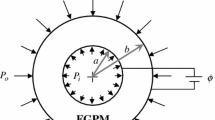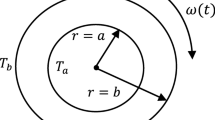Abstract
In this paper, the behavior of functionally graded material hollow cylinders with an elliptic hole under thermal and mechanical loads is investigated. The problem is considered as plane strain condition, and to obtain the governing equations and boundary condition for this complex geometry, an elliptic cylindrical coordinate is used. The material properties are considered to vary along the elliptic cylindrical direction with power-law function except for the Poisson’s ratio. To solve the two coupled differential equations, differential quadrature method is used. For solving the governing equations, two different boundary conditions are considered for thermal and mechanical loads. The results show that unconventional shape for a hole in the cylinder can affect the results expected such as stresses or displacements, and this information about thermo-mechanical loads can be used for designing the advanced sensors. Also with considering special material index, the stress and displacement along the cylinder can be controlled. The presented results in this paper are verified with those reported in the previous publication.
























Similar content being viewed by others
References
Hosseini-Hashemi S, Derakhshani M, Fadaee M (2013) An accurate mathematical study on the free vibration of stepped thickness circular/annular Mindlin functionally graded plates. Appl Math Model 37(6):4147–4164. https://doi.org/10.1016/j.apm.2012.08.002
Alashti RA, Khorsand M, Tarahhomi MH (2012) Asymmetric thermo-elastic analysis of long cylindrical shells of functionally graded materials by differential quadrature method. Proc Inst Mech Eng Part C J Mech Eng Sci 226(5):1133–1147. https://doi.org/10.1177/0954406211420037
Heydarpour Y, Malekzadeh P, Golbahar Haghighi MR, Vaghefi M (2012) Thermoelastic analysis of rotating laminated functionally graded cylindrical shells using layerwise differential quadrature method. Acta Mech 223(1):81–93. https://doi.org/10.1007/s00707-011-0551-6
Malekzadeh P, Ghaedsharaf M (2014) Three-dimensional thermoelastic analysis of finite length laminated cylindrical panels with functionally graded layers. Meccanica 49(4):887–906. https://doi.org/10.1007/s11012-013-9836-2
Rajasekaran S (2013) Differential transformation and differential quadrature methods for centrifugally stiffened axially functionally graded tapered beams. Int J Mech Sci 74:15–31. https://doi.org/10.1016/j.ijmecsci.2013.04.004
Zhang J-H, Li G-Z, Li S-R, Ma Y-B (2015) DQM-based thermal stresses analysis of a functionally graded cylindrical shell under thermal shock. J Therm Stress 38(9):959–982. https://doi.org/10.1080/01495739.2015.1038488
Ghorbanpour Arani A, Jafari Fesharaki J, Mohammadimehr M, Golabi S (2010) Electro-magneto-thermo-mechanical behaviors of a radially polarized FGPM thick hollow sphere. J Solid Mech 2(4):305–315
Zamani Nejad M, Jabbari M, Ghannad M (2017) A general disk form formulation for thermo-elastic analysis of functionally graded thick shells of revolution with arbitrary curvature and variable thickness. Acta Mech 228(1):215–231. https://doi.org/10.1007/s00707-016-1709-z
Zidi M, Tounsi A, Houari MSA, Adda Bedia EA, Anwar Bég O (2014) Bending analysis of FGM plates under hygro-thermo-mechanical loading using a four variable refined plate theory. Aerosp Sci Technol 34:24–34. https://doi.org/10.1016/j.ast.2014.02.001
Akavci SS (2016) Mechanical behavior of functionally graded sandwich plates on elastic foundation. Compos B Eng 96:136–152. https://doi.org/10.1016/j.compositesb.2016.04.035
Tung HV, Duc ND (2014) Nonlinear response of shear deformable FGM curved panels resting on elastic foundations and subjected to mechanical and thermal loading conditions. Appl Math Model 38(11):2848–2866. https://doi.org/10.1016/j.apm.2013.11.015
Eskandari H (2016) Stress intensity factor of semi-elliptical surface crack in a thermo-mechanically loaded cylinder with hoop wrapped FGM layer. J Braz Soc Mech Sci Eng 38(8):2563–2570. https://doi.org/10.1007/s40430-016-0495-9
Fesharaki JJ, Loghman A, Yazdipoor M, Golabi S (2014) Semi-analytical solution of time-dependent thermomechanical creep behavior of FGM hollow spheres. Mech Time-Depend Mater 18(1):41–53. https://doi.org/10.1007/s11043-013-9212-6
Fesharaki JJ, Si Golabi (2016) A novel method to specify pattern recognition of actuators for stress reduction based on particle swarm optimization method. Smart Struct Syst 17(5):725–742
Hosseini M, Dini A, Eftekhari M (2017) Strain gradient effects on the thermoelastic analysis of a functionally graded micro-rotating cylinder using generalized differential quadrature method. Acta Mech 228(5):1563–1580. https://doi.org/10.1007/s00707-016-1780-5
Alibeigloo A (2017) Thermo elasticity solution of functionally graded, solid, circular, and annular plates integrated with piezoelectric layers using the differential quadrature method. Mech Adv Mater Struct. https://doi.org/10.1080/15376494.2017.1308585
Alibeigloo A (2016) Thermo elasticity solution of sandwich circular plate with functionally graded core using generalized differential quadrature method. Compos Struct 136:229–240. https://doi.org/10.1016/j.compstruct.2015.10.012
Karami B, Janghorban M, Tounsi A (2018) Variational approach for wave dispersion in anisotropic doubly-curved nanoshells based on a new nonlocal strain gradient higher order shell theory. Thin-Walled Struct 129:251–264. https://doi.org/10.1016/j.tws.2018.02.025
Atrian A, Jafari Fesharaki J, Nourbakhsh SH (2015) Thermo-electromechanical behavior of functionally graded piezoelectric hollow cylinder under non-axisymmetric loads. Appl Math Mech 36(7):939–954. https://doi.org/10.1007/s10483-015-1959-9
Sobhani Aragh B, Yas MH (2010) Three-dimensional analysis of thermal stresses in four-parameter continuous grading fiber reinforced cylindrical panels. Int J Mech Sci 52(8):1047–1063. https://doi.org/10.1016/j.ijmecsci.2010.04.006
Karami G, Malekzadeh P (2002) Static and stability analyses of arbitrary straight-sided quadrilateral thin plates by DQM. Int J Solids Struct 39(19):4927–4947. https://doi.org/10.1016/S0020-7683(02)00403-1
Alinaghizadeh F, Shariati M (2015) Static analysis of variable thickness two-directional functionally graded annular sector plates fully or partially resting on elastic foundations by the GDQ method. J Braz Soc Mech Sci Eng 37(6):1819–1838. https://doi.org/10.1007/s40430-015-0427-0
Malekzadeh P, Safaeian Hamzehkolaei N (2016) Temperature-dependent discrete layer-differential quadrature bending analysis of the multi-layered functionally graded annular plates rested on a two-parameter elastic foundation. Mech Adv Mater Struct 23(1):43–58. https://doi.org/10.1080/15376494.2014.928839
Mehditabar A, Rahimi GH, Ansari Sadrabadi S (2017) Three-dimensional magneto-thermo-elastic analysis of functionally graded cylindrical shell. Appl Math Mech 38(4):479–494. https://doi.org/10.1007/s10483-017-2186-6
Alashti RA, Khorsand M (2012) Three-dimensional nonlinear thermo-elastic analysis of functionally graded cylindrical shells with piezoelectric layers by differential quadrature method. Acta Mech 223(12):2565–2590. https://doi.org/10.1007/s00707-012-0716-y
Adineh M, Kadkhodayan M (2017) Three-dimensional thermo-elastic analysis and dynamic response of a multi-directional functionally graded skew plate on elastic foundation. Compos B Eng 125:227–240. https://doi.org/10.1016/j.compositesb.2017.05.070
Jafari Fesharaki J, Jafari Fesharaki V, Yazdipoor M, Razavian B (2012) Two-dimensional solution for electro-mechanical behavior of functionally graded piezoelectric hollow cylinder. Appl Math Model 36(11):5521–5533. https://doi.org/10.1016/j.apm.2012.01.019
Franco Correia VM, Aguilar Madeira JF, Araújo AL, Mota Soares CM (2018) Multiobjective optimization of ceramic-metal functionally graded plates using a higher order model. Compos Struct 183:146–160. https://doi.org/10.1016/j.compstruct.2017.02.013
Setoodeh AR, Shojaee M, Malekzadeh P (2018) Application of transformed differential quadrature to free vibration analysis of FG-CNTRC quadrilateral spherical panel with piezoelectric layers. Comput Methods Appl Mech Eng 335:510–537. https://doi.org/10.1016/j.cma.2018.02.022
He M-X, Sun J-Q (2018) Multi-objective structural-acoustic optimization of beams made of functionally graded materials. Compos Struct 185:221–228. https://doi.org/10.1016/j.compstruct.2017.11.004
Jamshidi M, Arghavani J (2018) Optimal material tailoring of functionally graded porous beams for buckling and free vibration behaviors. Mech Res Commun 88:19–24. https://doi.org/10.1016/j.mechrescom.2018.01.006
Meziane MAA, Abdelaziz HH, Tounsi A (2014) An efficient and simple refined theory for buckling and free vibration of exponentially graded sandwich plates under various boundary conditions. J Sandwich Struct Mater 16(3):293–318. https://doi.org/10.1177/1099636214526852
Hussein OS, Mulani SB (2018) Optimization of in-plane functionally graded panels for buckling strength: unstiffened, stiffened panels, and panels with cutouts. Thin-Walled Struct 122:173–181. https://doi.org/10.1016/j.tws.2017.10.025
Boussaa D (2009) Optimization of temperature-dependent functionally graded material bodies. Comput Methods Appl Mech Eng 198(37):2827–2838. https://doi.org/10.1016/j.cma.2009.02.013
Shu C (2000) Differential quadrature and its application in engineering. Springer, London
Malik M, Bert CW (1994) Differential quadrature solutions for steady-state incompressible and compressible lubrication problems. J Tribol 116(2):296–302. https://doi.org/10.1115/1.2927214
Horgan CO, Chan AM (1999) The pressurized hollow cylinder or disk problem for functionally graded isotropic linearly elastic materials. J Elast 55(1):43–59. https://doi.org/10.1023/a:1007625401963
Heinbockel JH (2001) Introduction to tensor calculus and continuum mechanics. Trafford Publishing. ISBN-13: 978-1553691334
Author information
Authors and Affiliations
Corresponding author
Additional information
Technical Editor: João Marciano Laredo dos Reis.
Publisher's Note
Springer Nature remains neutral with regard to jurisdictional claims in published maps and institutional affiliations.
Appendices
Appendix A
The relations between elliptic cylindrical coordinate and Cartesian coordinate are presented as [38]:
And the coordinate curves formed by the intersection of coordinate are as follows:
Accordingly, the position vector for each point is:
And the unit vector for each direction is shown as:
where “A” for simplicity is defined as:
Displacement vector in elliptic cylindrical coordinate is defined:
The strain tensor is defined as:
Using Eqs. (38)–(42) and substituting Eq. (43) into Eq. (44), the strains yield as:
Appendix B
The static equilibrium equation in a linear elastic material is expressed:
where \(\sigma_{i, j}^{i}\), \(\varrho\) and \(b_{i}\) are stress tensor derivatives, density and the external body forces, respectively. Assuming an orthogonal coordinate system, the \(\sigma_{i,j}^{i}\) is expressed [38]:
where “g” is the metric components of the orthogonal system and expressed as:
And the equilibrium equations are presented as:
where there is no summation on “i.”
Using Eqs. (46)–(49) and (38), the equilibrium equations along the “ψ” and “η” directions are presented, respectively, as:
Appendix C
The constants for material properties in Eqs. (18) and (19) are as follows:
Rights and permissions
About this article
Cite this article
Fesharaki, J.J., Roghani, M. Thermo-mechanical behavior of a functionally graded hollow cylinder with an elliptic hole. J Braz. Soc. Mech. Sci. Eng. 42, 66 (2020). https://doi.org/10.1007/s40430-019-2135-7
Received:
Accepted:
Published:
DOI: https://doi.org/10.1007/s40430-019-2135-7




